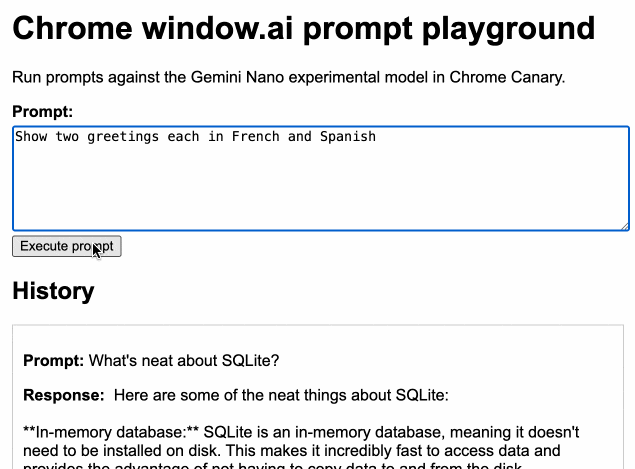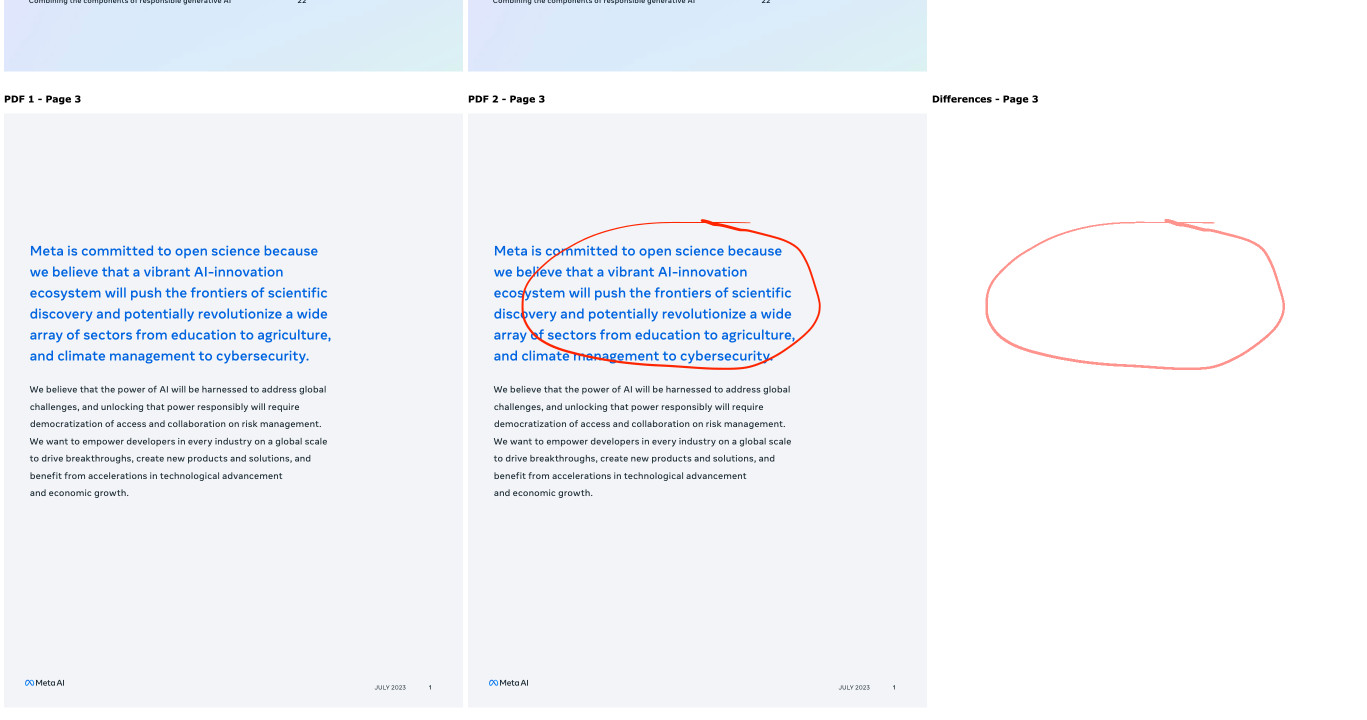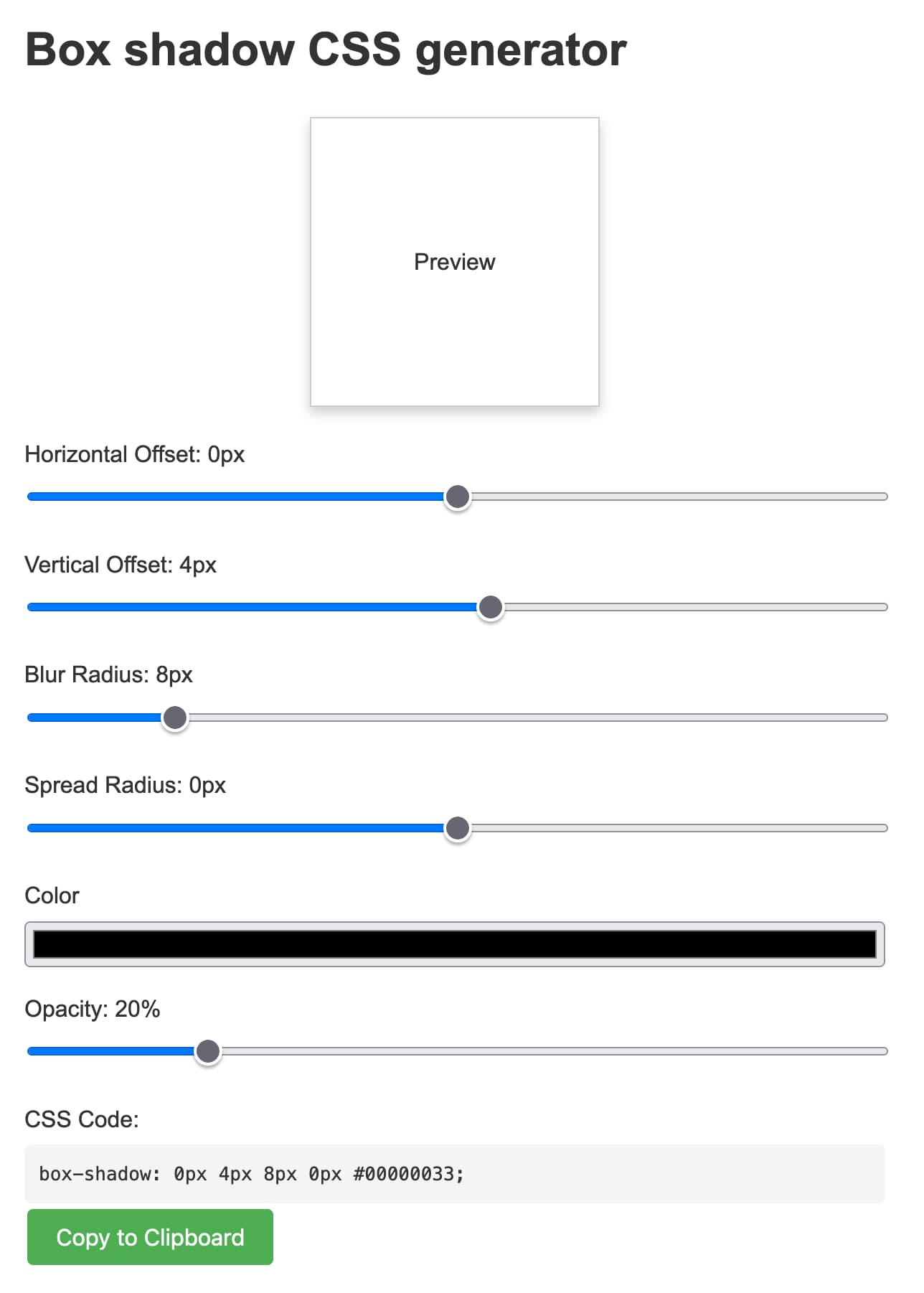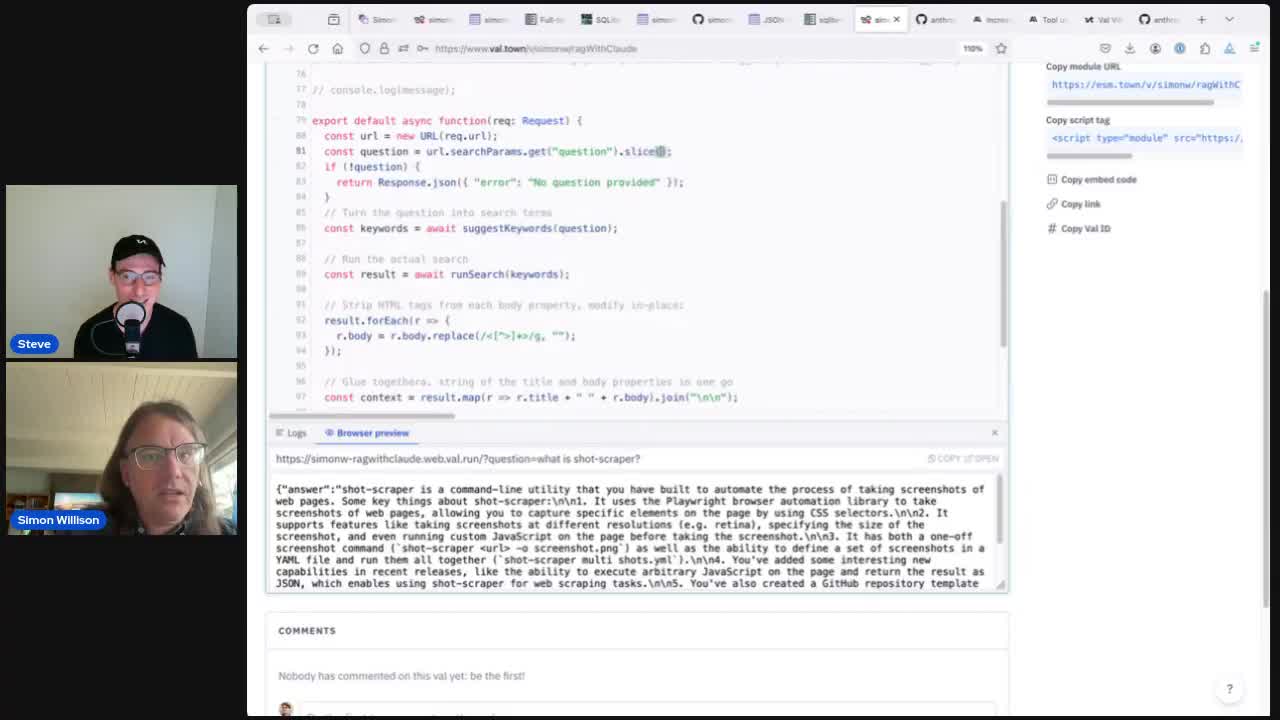1,514 posts tagged “llms”
Large Language Models (LLMs) are the class of technology behind generative text AI systems like OpenAI's ChatGPT, Google's Gemini and Anthropic's Claude.
2024
So much of knowledge/intelligence involves translating ideas between fields (domains). Those domains are walls the keep ideas siloed. But LLMs can help break those walls down and encourage humans to do more interdisciplinary thinking, which may lead to faster discoveries.
And note that I am implying that humans will make the breakthroughs, using LLMs as translation tools when appropriate, to help make connections. LLMs are strongest as translators of information that you provide. BYOD: Bring your own data!
Imitation Intelligence, my keynote for PyCon US 2024
I gave an invited keynote at PyCon US 2024 in Pittsburgh this year. My goal was to say some interesting things about AI—specifically about Large Language Models—both to help catch people up who may not have been paying close attention, but also to give people who were paying close attention some new things to think about.
[... 10,624 words]The Death of the Junior Developer (via) Steve Yegge's speculative take on the impact LLM-assisted coding could have on software careers.
Steve works on Cody, an AI programming assistant, so he's hardly an unbiased source of information. Nevertheless, his collection of anecdotes here matches what I've been seeing myself.
Steve coins the term here CHOP, for Chat Oriented Programming, where the majority of code is typed by an LLM that is directed by a programmer. Steve describes it as "coding via iterative prompt refinement", and argues that the models only recently got good enough to support this style with GPT-4o, Gemini Pro and Claude 3 Opus.
I've been experimenting with this approach myself on a few small projects (see this Claude example) and it really is a surprisingly effective way to work.
Also included: a story about how GPT-4o produced a bewitchingly tempting proposal with long-term damaging effects that only a senior engineer with deep understanding of the problem space could catch!
I'm in strong agreement with this thought on the skills that are becoming most important:
Everyone will need to get a lot more serious about testing and reviewing code.
Why The Atlantic signed a deal with OpenAI. Interesting conversation between Nilay Patel and The Atlantic CEO (and former journalist/editor) Nicholas Thompson about the relationship between media organizations and LLM companies like OpenAI.
On the impact of these deals on the ongoing New York Times lawsuit:
One of the ways that we [The Atlantic] can help the industry is by making deals and setting a market. I believe that us doing a deal with OpenAI makes it easier for us to make deals with the other large language model companies if those come about, I think it makes it easier for other journalistic companies to make deals with OpenAI and others, and I think it makes it more likely that The Times wins their lawsuit.
How could it help? Because deals like this establish a market value for training content, important for the fair use component of the legal argument.
Yeah, unfortunately vision prompting has been a tough nut to crack. We've found it's very challenging to improve Claude's actual "vision" through just text prompts, but we can of course improve its reasoning and thought process once it extracts info from an image.
In general, I think vision is still in its early days, although 3.5 Sonnet is noticeably better than older models.
— Alex Albert, Anthropic
Anthropic cookbook: multimodal. I'm currently on the lookout for high quality sources of information about vision LLMs, including prompting tricks for getting the most out of them.
This set of Jupyter notebooks from Anthropic (published four months ago to accompany the original Claude 3 models) is the best I've found so far. Best practices for using vision with Claude includes advice on multi-shot prompting with example, plus this interesting think step-by-step style prompt for improving Claude's ability to count the dogs in an image:
You have perfect vision and pay great attention to detail which makes you an expert at counting objects in images. How many dogs are in this picture? Before providing the answer in
<answer>tags, think step by step in<thinking>tags and analyze every part of the image.
Vision language models are blind (via) A new paper exploring vision LLMs, comparing GPT-4o, Gemini 1.5 Pro, Claude 3 Sonnet and Claude 3.5 Sonnet (I'm surprised they didn't include Claude 3 Opus and Haiku, which are more interesting than Claude 3 Sonnet in my opinion).
I don't like the title and framing of this paper. They describe seven tasks that vision models have trouble with - mainly geometric analysis like identifying intersecting shapes or counting things - and use those to support the following statement:
The shockingly poor performance of four state-of-the-art VLMs suggests their vision is, at best, like of a person with myopia seeing fine details as blurry, and at worst, like an intelligent person that is blind making educated guesses.
While the failures they describe are certainly interesting, I don't think they justify that conclusion.
I've felt starved for information about the strengths and weaknesses of these vision LLMs since the good ones started becoming available last November (GPT-4 Vision at OpenAI DevDay) so identifying tasks like this that they fail at is useful. But just like pointing out an LLM can't count letters doesn't mean that LLMs are useless, these limitations of vision models shouldn't be used to declare them "blind" as a sweeping statement.
Claude: You can now publish, share, and remix artifacts. Artifacts is the feature Anthropic released a few weeks ago to accompany Claude 3.5 Sonnet, allowing Claude to create interactive HTML+JavaScript tools in response to prompts.
This morning they added the ability to make those artifacts public and share links to them, which makes them even more useful!
Here's my box shadow playground from the other day, and an example page I requested demonstrating the Milligram CSS framework - Artifacts can load most code that is available via cdnjs so they're great for quickly trying out new libraries.
hangout_services/thunk.js
(via)
It turns out Google Chrome (via Chromium) includes a default extension which makes extra services available to code running on the *.google.com domains - tweeted about today by Luca Casonato, but the code has been there in the public repo since October 2013 as far as I can tell.
It looks like it's a way to let Google Hangouts (or presumably its modern predecessors) get additional information from the browser, including the current load on the user's CPU. Update: On Hacker News a Googler confirms that the Google Meet "troubleshooting" feature uses this to review CPU utilization.
I got GPT-4o to help me figure out how to trigger it (I tried Claude 3.5 Sonnet first but it refused, saying "Doing so could potentially violate terms of service or raise security and privacy concerns"). Paste the following into your Chrome DevTools console on any Google site to see the result:
chrome.runtime.sendMessage(
"nkeimhogjdpnpccoofpliimaahmaaome",
{ method: "cpu.getInfo" },
(response) => {
console.log(JSON.stringify(response, null, 2));
},
);
I get back a response that starts like this:
{
"value": {
"archName": "arm64",
"features": [],
"modelName": "Apple M2 Max",
"numOfProcessors": 12,
"processors": [
{
"usage": {
"idle": 26890137,
"kernel": 5271531,
"total": 42525857,
"user": 10364189
}
}, ...
The code doesn't do anything on non-Google domains.
Luca says this - I'm inclined to agree:
This is interesting because it is a clear violation of the idea that browser vendors should not give preference to their websites over anyone elses.
Inside the labs we have these capable models, and they're not that far ahead from what the public has access to for free. And that's a completely different trajectory for bringing technology into the world that what we've seen historically. It's a great opportunity because it brings people along. It gives them intuitive sense for the capabilities and risks and allows people to prepare for the advent of bringing advanced AI into the world.
Jevons paradox (via) I've been thinking recently about how the demand for professional software engineers might be affected by the fact that LLMs are getting so good at producing working code, when prompted in the right way.
One possibility is that the price for writing code will fall, in a way that massively increases the demand for custom solutions - resulting in a greater demand for software engineers since the increased value they can provide makes it much easier to justify the expense of hiring them in the first place.
TIL about the related idea of the Jevons paradox, currently explained by Wikipedia like so:
[...] when technological progress increases the efficiency with which a resource is used (reducing the amount necessary for any one use), but the falling cost of use induces increases in demand enough that resource use is increased, rather than reduced.
Box shadow CSS generator (via) Another example of a tiny personal tool I built using Claude 3.5 Sonnet and artifacts. In this case my prompt was:
CSS for a slight box shadow, build me a tool that helps me twiddle settings and preview them and copy and paste out the CSS
I changed my mind half way through typing the prompt and asked it for a custom tool, and it built me this!
Here's the full transcript - in a follow-up prompt I asked for help deploying it and it rewrote the tool to use <script type="text/babel"> and the babel-standalone library to add React JSX support directly in the browser - a bit of a hefty dependency (387KB compressed / 2.79MB total) but I think acceptable for this kind of one-off tool.
Being able to knock out tiny custom tools like this on a whim is a really interesting new capability. It's also a lot of fun!
Home-Cooked Software and Barefoot Developers. I really enjoyed this talk by Maggie Appleton from this year's Local-first Conference in Berlin.
For the last ~year I've been keeping a close eye on how language models capabilities meaningfully change the speed, ease, and accessibility of software development. The slightly bold theory I put forward in this talk is that we're on a verge of a golden age of local, home-cooked software and a new kind of developer – what I've called the barefoot developer.
It's a great talk, and the design of the slides is outstanding.
It reminded me of Robin Sloan's An app can be a home-cooked meal, which Maggie references in the talk. Also relevant: this delightful recent Hacker News thread, Ask HN: Is there any software you only made for your own use but nobody else?
My favourite version of our weird new LLM future is one where the pool of people who can use computers to automate things in their life is massively expanded.
The other videos from the conference are worth checking out too.
The expansion of the jagged frontier of AI capability is subtle and requires a lot of experience with various models to understand what they can, and can’t, do. That is why I suggest that people and organizations keep an “impossibility list” - things that their experiments have shown that AI can definitely not do today but which it can almost do. For example, no AI can create a satisfying puzzle or mystery for you to solve, but they are getting closer. When AI models are updated, test them on your impossibility list to see if they can now do these impossible tasks.
Chrome Prompt Playground.
Google Chrome Canary is currently shipping an experimental on-device LLM, in the form of Gemini Nano. You can access it via the new window.ai API, after first enabling the "Prompt API for Gemini Nano" experiment in chrome://flags (and then waiting an indeterminate amount of time for the ~1.7GB model file to download - I eventually spotted it in ~/Library/Application Support/Google/Chrome Canary/OptGuideOnDeviceModel).
I got Claude 3.5 Sonnet to build me this playground interface for experimenting with the model. You can execute prompts, stream the responses and all previous prompts and responses are stored in localStorage.

Here's the full Sonnet transcript, and the final source code for the app.
The best documentation I've found for the new API is is explainers-by-googlers/prompt-api on GitHub.
gemma-2-27b-it-llamafile (via) Justine Tunney shipped llamafile packages of Google's new openly licensed (though definitely not open source) Gemma 2 27b model this morning.
I downloaded the gemma-2-27b-it.Q5_1.llamafile version (20.5GB) to my Mac, ran chmod 755 gemma-2-27b-it.Q5_1.llamafile and then ./gemma-2-27b-it.Q5_1.llamafile and now I'm trying it out through the llama.cpp default web UI in my browser. It works great.
It's a very capable model - currently sitting at position 12 on the LMSYS Arena making it the highest ranked open weights model - one position ahead of Llama-3-70b-Instruct and within striking distance of the GPT-4 class models.
Compare PDFs. Inspired by this thread on Hacker News about the C++ diff-pdf tool I decided to see what it would take to produce a web-based PDF diff visualization tool using Claude 3.5 Sonnet.
It took two prompts:
Build a tool where I can drag and drop on two PDF files and it uses PDF.js to turn each of their pages into canvas elements and then displays those pages side by side with a third image that highlights any differences between them, if any differences exist
That give me a React app that didn't quite work, so I followed-up with this:
rewrite that code to not use React at all
Which gave me a working tool! You can see the full Claude transcript in this Gist. Here's a screenshot of the tool in action:

Being able to knock out little custom interactive web tools like this in a couple of minutes is so much fun.
Absolutely any time I try to explore something even slightly against commonly accepted beliefs, LLMs always just rehash the commonly accepted beliefs.
As a researcher, I find this behaviour worse than unhelpful. It gives the mistaken impression that there's nothing to explore.
We argued that ChatGPT is not designed to produce true utterances; rather, it is designed to produce text which is indistinguishable from the text produced by humans. It is aimed at being convincing rather than accurate. The basic architecture of these models reveals this: they are designed to come up with a likely continuation of a string of text. It’s reasonable to assume that one way of being a likely continuation of a text is by being true; if humans are roughly more accurate than chance, true sentences will be more likely than false ones. This might make the chatbot more accurate than chance, but it does not give the chatbot any intention to convey truths. This is similar to standard cases of human bullshitters, who don’t care whether their utterances are true; good bullshit often contains some degree of truth, that’s part of what makes it convincing.
Open challenges for AI engineering
I gave the opening keynote at the AI Engineer World’s Fair yesterday. I was a late addition to the schedule: OpenAI pulled out of their slot at the last minute, and I was invited to put together a 20 minute talk with just under 24 hours notice!
[... 5,640 words]picopilot (via) Kyle Carberry's "GitHub Copilot in 70 lines of JavaScript". The title is a little hyperbolic, but the code itself really does implement an OpenAI powered Visual Studio Code text completion extension in 71 lines of code. This is an excellent example for learning what a minimal VS Code extension looks like.
Here's the system prompt it uses:
You provide code completion results given a prefix and suffix. Respond with a JSON object with the key 'completion' containing a suggestion to place between the prefix and suffix. Follow existing code styles. Listen to comments at the end of the prefix. The language is "{language}".
Then it passes the prefix and suffix as two user messages, and uses the "response_format": {"type": "json_object"} option to enforce JSON output from the GPT-4o API.
The feature this is missing is the thing that makes GitHub Copilot so impressive: Copilot does a whole bunch of clever tricks to find snippets of relevant code from the current and other nearby files and includes them with the prompt, resulting in much higher quality completions.
Claude Projects. New Claude feature, quietly launched this morning for Claude Pro users. Looks like their version of OpenAI's GPTs, designed to take advantage of Claude's 200,000 token context limit:
You can upload relevant documents, text, code, or other files to a project’s knowledge base, which Claude will use to better understand the context and background for your individual chats within that project. Each project includes a 200K context window, the equivalent of a 500-page book, so users can add all of the insights needed to enhance Claude’s effectiveness.
You can also set custom instructions, which presumably get added to the system prompt.
I tried dropping in all of Datasette's existing documentation - 693KB of .rst files (which I had to rename to .rst.txt for it to let me upload them) - and it worked and showed "63% of knowledge size used".
This is a slightly different approach from OpenAI, where the GPT knowledge feature supports attaching up to 20 files each with up to 2 million tokens, which get ingested into a vector database (likely Qdrant) and used for RAG.
It looks like Claude instead handle a smaller amount of extra knowledge but paste the whole thing into the context window, which avoids some of the weirdness around semantic search chunking but greatly limits the size of the data.
My big frustration with the knowledge feature in GPTs remains the lack of documentation on what it's actually doing under the hood. Without that it's difficult to make informed decisions about how to use it - with Claude Projects I can at least develop a robust understanding of what the tool is doing for me and how best to put it to work.
No equivalent (yet) for the GPT actions feature where you can grant GPTs the ability to make API calls out to external systems.
What Apple unveiled last week with Apple Intelligence wasn't so much new products, but new features—a slew of them—for existing products, powered by generative AI.
[...] These aren't new apps or new products. They're the most used, most important apps Apple makes, the core apps that define the Apple platforms ecosystem, and Apple is using generative AI to make them better and more useful—without, in any way, rendering them unfamiliar.
llama.ttf (via) llama.ttf is "a font file which is also a large language model and an inference engine for that model".
You can see it kick into action at 8m28s in this video, where creator Søren Fuglede Jørgensen types "Once upon a time" followed by dozens of exclamation marks, and those exclamation marks then switch out to render a continuation of the story. But... when they paste the code out of the editor again it shows as the original exclamation marks were preserved - the LLM output was presented only in the way they were rendered.
The key trick here is that the font renderer library HarfBuzz (used by Firefox, Chrome, Android, GNOME and more) added a new WebAssembly extension in version 8.0 last year, which is powerful enough to run a full LLM based on the tinyllama-15M model - which fits in a 60MB font file.
(Here's a related demo from Valdemar Erk showing Tetris running in a WASM font, at 22m56s in this video.)
The source code for llama.ttf is available on GitHub.
In our “who validates the validators” user studies, we found that people expected—and also desired—for the LLM to learn from any human interaction. That too, “as efficiently as possible” (ie after 1-2 demonstrations, the LLM should “get it”)
Building search-based RAG using Claude, Datasette and Val Town
Retrieval Augmented Generation (RAG) is a technique for adding extra “knowledge” to systems built on LLMs, allowing them to answer questions against custom information not included in their training data. A common way to implement this is to take a question from a user, translate that into a set of search queries, run those against a search engine and then feed the results back into the LLM to generate an answer.
[... 3,372 words]llm-claude-3 0.4. LLM plugin release adding support for the new Claude 3.5 Sonnet model:
pipx install llm
llm install -U llm-claude-3
llm keys set claude
# paste AP| key here
llm -m claude-3.5-sonnet \
'a joke about a pelican and a walrus having lunch'
One of the core constitutional principles that guides our AI model development is privacy. We do not train our generative models on user-submitted data unless a user gives us explicit permission to do so. To date we have not used any customer or user-submitted data to train our generative models.
Claude 3.5 Sonnet. Anthropic released a new model this morning, and I think it's likely now the single best available LLM. Claude 3 Opus was already mostly on-par with GPT-4o, and the new 3.5 Sonnet scores higher than Opus on almost all of Anthropic's internal evals.
It's also twice the speed and one fifth of the price of Opus (it's the same price as the previous Claude 3 Sonnet). To compare:
- gpt-4o: $5/million input tokens and $15/million output
- Claude 3.5 Sonnet: $3/million input, $15/million output
- Claude 3 Opus: $15/million input, $75/million output
Similar to Claude 3 Haiku then, which both under-cuts and out-performs OpenAI's GPT-3.5 model.
In addition to the new model, Anthropic also added a "artifacts" feature to their Claude web interface. The most exciting part of this is that any of the Claude models can now build and then render web pages and SPAs, directly in the Claude interface.
This means you can prompt them to e.g. "Build me a web app that teaches me about mandelbrot fractals, with interactive widgets" and they'll do exactly that - I tried that prompt on Claude 3.5 Sonnet earlier and the results were spectacular (video demo).
An unsurprising note at the end of the post:
To complete the Claude 3.5 model family, we’ll be releasing Claude 3.5 Haiku and Claude 3.5 Opus later this year.
If the pricing stays consistent with Claude 3, Claude 3.5 Haiku is going to be a very exciting model indeed.
Tags with descriptions. Tiny new feature on my blog: I can now add optional descriptions to my tag pages, for example on datasette and sqlite-utils and prompt-injection.
I built this feature on a live call this morning as an unplanned demonstration of GitHub's new Copilot Workspace feature, where you can run a prompt against a repository and have it plan, implement and file a pull request implementing a change to the code.
My prompt was:
Add a feature that lets me add a description to my tag pages, stored in the database table for tags and visible on the /tags/x/ page at the top
It wasn't as compelling a demo as I expected: Copilot Workspace currently has to stream an entire copy of each file it modifies, which can take a long time if your codebase includes several large files that need to be changed.
It did create a working implementation on its first try, though I had given it an extra tip not to forget the database migration. I ended up making a bunch of changes myself before I shipped it, listed in the pull request.
I've been using Copilot Workspace quite a bit recently as a code explanation tool - I'll prompt it to e.g. "add architecture documentation to the README" on a random repository not owned by me, then read its initial plan to see what it's figured out without going all the way through to the implementation and PR phases. Example in this tweet where I figured out the rough design of the Jina AI Reader API for this post.



